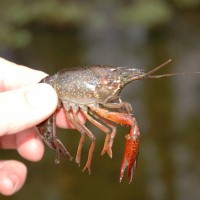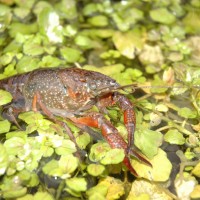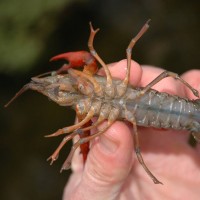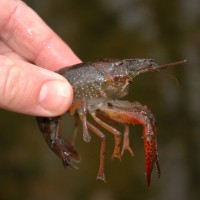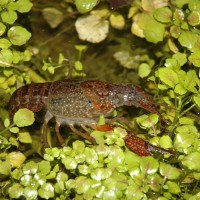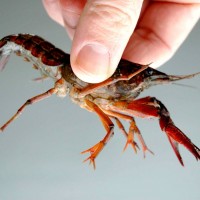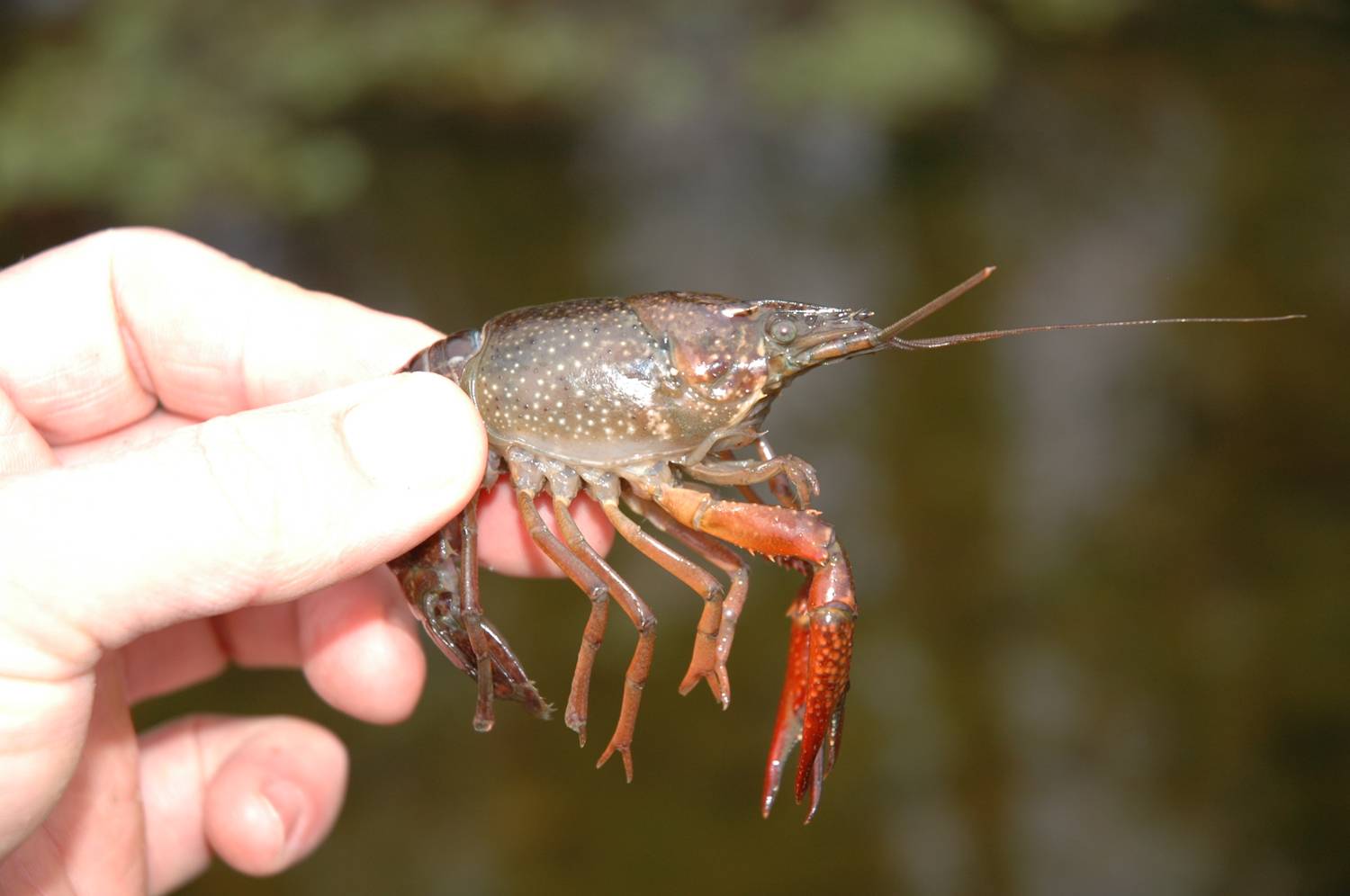
Red Swamp Crayfish - Procambarus clarkii
Expand and collapse the sections below by clicking on the title or + / - icons.
Short description of Procambarus clarkii, Red Swamp Crayfish
The red swamp crayfish is dark red, covered in bright red spots and has a black wedge-shaped stripe on the top of the abdomen. Adults reach 85-90mm total length and are aggressive in behaviour.
Impact summary: Procambarus clarkii, Red Swamp Crayfish
Red swamp crayfish may cause significant changes in aquatic food webs by feeding at several trophic levels. They may threaten the survival of native crayfish populations by carrying crayfish plague, and out-competing the smaller, less aggressive white clawed crayfish. Burrowing may destabilise banks and increase turbidity, increasing costs for water processing and construction on the edges of water bodies. Changes in food webs and turbidity levels may affect algal growth which could lead to toxic algal blooms that could cause skin irritation to swimmers.
Habitat summary: Procambarus clarkii, Red Swamp Crayfish
Red swamp crayfish populations are currently found in ponds, ditches, canals and rivers in the UK but are tolerant to a wide range of environmental conditions. They can withstand changes in water flow, drying out and salinity, so inundated wetland, reed bed, drainage channels and coastal marshes may also be suitable habitat.
Overview table
| Environment | Freshwater |
|---|---|
| Species status | Non-Native |
| Native range | Southeastern U.S.A., Mexico |
| Functional type | Omnivore |
| Status in England | Non-Native |
| Status in Scotland | |
| Status in Wales | |
| Location of first record | Hampstead Heath |
| Date of first record | 1991 |
Origin
Northeast Mexico and southern USA
First Record
The first sightings were confirmed in a roadside marsh drain near Tilbury and the Grand Union Canal in 1990. Populations were found in Hampstead Heath ponds the following year.
Pathway and Method
The red swamp crayfish was intentionally introduced into several European countries in an effort to replace diminished stocks of native species. Transport of crayfish into the UK for human consumption was legal and it is likely that crayfish may have escaped or been released from sources intended for food.
Species Status
The red swamp crayfish is the most widespread of all crayfish species, present in all continents except Australia and Antarctica. Populations are found in 13 different countries in Europe where it has been introduced for aquaculture but has escaped and become invasive. After initial sightings in the UK in 1990, breeding populations were found in five ponds in Hampstead Heath, and in the nearby Regents Canal in London.
Dispersal Mechanisms
Red swamp crayfish have escaped from farms or been released from aquaria, and can then readily travel long distances to reach water. Crayfish are able to disperse in natural waterways or walk overland to find suitable conditions. They can survive for extended periods out of water and are also able to climb quite well. Dispersal distances of up to 3km in a single night have been recorded. Individuals may also be transported between water bodies by birds such as herons.
Reproduction
Red swamp crayfish have a high growth rate, high fecundity and short lifespan. In Britain, mating takes place in spring, spawning occurs July-August and juveniles hatch between August and October. They mature in 3 to 5 months and so are able to breed the following year. Females may lay up to 600 eggs at a time. Reproduction is highly temperature dependent, slowing in cool climates and ceasing below about 10 degrees, but increasing to two breeding cycles are year in warmer regions.
Known Predators/Herbivores
Studies in Spain and Portugal indicate that small mammals such as red fox and otter, large birds including herons and storks, and fish such as pike and bass predate red swamp crayfish. In Britain it is believed that eels could be important predators.
Resistant Stages
Adults are highly resistant to extremes in environmental conditions. They can tolerate eutrophication, low oxygen levels, salinities up to 10ppt and can survive extended periods of drought by burrowing. They are resistant but act as a vector for crayfish plague.
Habitat Occupied in GB
There are currently only a few established populations in GB. These are found in ponds, rivers, drainage ditches and canals.
Environmental Impact
Red swamp crayfish are large and highly fecund, and so populations can quickly cause changes in aquatic food webs. They are omnivorous, with food sources including detritus, macroinvertebrates, green plants, juvenile fish and amphibians, and have been implicated in species declines in some areas. Extensive burrowing can cause increases in turbidity which reduce light penetration for plant growth and may contribute to ecosystem state shifts. As a vector for crayfish plague as well as an aggressive competitor for resources, they threaten populations of native crayfish species. They accumulate heavy metals which can poison predators higher up the food chain.
Health and Social Impact
High levels of burrowing by the red swamp crayfish increase turbidity in water bodies which can encourage growth of planktonic algae. Growth of blue-green algae can release high levels of toxins that cause irritation to swimmers, whilst increased levels of all algae increase the need for treatment of reservoir water. In Africa, however, red swamp crayfish are successfully limiting the populations of snails that pass on schistosomiasis, offering benefits for local people.
Economic Impact
Red swamp crayfish dig long burrows, which are more frequent and extensive than those of other invaders such as the signal crayfish. This can cause extensive damage to river banks, structures such as dams and reservoirs, and can cause leakage from water bodies. Increased turbidity caused by burrowing can make water processing and filtration more expensive.
Identification
Red swamp crayfish factsheet - http:dnr.wi.govinvasivespdfsredcrayfish.pdf
Biology, ecology, spread, vectors
Correia, A.M. (2001) Seasonal and interspecific evaluation of predation by mammals and birds on the introduced red swamp crayfish Procambarus clarkii (Crustacea, Cambaridae) in a freshwater marsh (Portugal). J. Zool. Lond., 255, 533-541.
Elvira, B., Nicola, G.G. & Almodovar, A. (1996) Pike and red swamp crayfish: a new case on predator-prey relationship between aliens in central Spain. Journal of Fish Biology, 48, 437-446.
Gherardi, F., Barbaresi, S. & Salvi, G. (2000) Spatial and temporal patterns in the movement of Procambarus clarkii, an invasive crayfish. Aquatic Science, 62, 179-193.
Management and impact
Aquiloni, L. & Gherardi, F. (2010) The use of sex pheromones for the control of invasive populations of the crayfish Procambarus clarkii: a field study. Hydrobiologia, 649, 249-254.
Correia, A.M., Bandeira, N. & Anastacio, P.M. (2005) Predator-prey interactions of Procambarus clarkii with aquatic macroinvertebrates in single and multiple prey systems. Acta Oecologica, 28, 337-343.
Gherardi, F. & Barbaresi, S. (2007) Feeding preferences of the invasive crayfish Procambarus clarkii. Bull. Fr. Peche. Piscic., 385, 7-20.
Gil-Sanchez, J.M. & Alba-Tercedor, J. (2002) Ecology of the native and introduced crayfishes Austropotmobius pallipes and Procambarus clarkii in southern Spain and implications for conservation of the native species. Biological Conservation, 105, 75-80.
Manchester, S.J. & Bullock, J.M. (2000) The impacts of non-native species on UK Biodiversity and the effectiveness of control. Journal of Applied Ecology, 37(5), 845-864.
Ilheu, M., Bernardo, J.M. & Fernandes, S. (year) Predation of invasive crayfish on aquatic vertebrates: the effect of Procambarus clarkii on fish assemblage in Mediterranean temporary streams. Chapter 29.
General
Anastacio, P.M. & Marques, J.C. (1995) Population biology and production of the red swamp crayfish Procambarus clarkii in the Lower Mondego River Valley, Portugal. Journal of Crustacean Biology, 15(1), 156-168.
Barbaresi, S. & Gherardi, F. (2000) The invasion of the alien crayfish Procambarus clarkii in Europe, with particular reference to Italy. Biological Invasions, 2, 259-264.
Foster, J. & Harper, D. (year) Status and ecosystem interactions of the invasive Louisiana red swamp crayfish Procambarus clarkii in East Africa. Chapter 4.
The Environment Agency- http:www.environment-agency.gov.ukresearchlibrarypublications103309.aspx
UK Non-native organisms risk assessment for Procambarus clarkii, the red swamp crayfish- February 2005. Prepared by CABI Bioscience (CABI), Centre for Environment, Fisheries and Aquaculture Science (CEFAS), Centre for Ecology and Hydrology (CEH), Central Science Laboratory (CSL), Imperial College London (IC) and the University of Greenwich (UoG).
https://www.cabi.org/isc/datasheet/67878
http://www.nonnativespecies.org/downloadDocument.cfm?id=46
Spotted this species?
Distribution map
View the Distribution map for Red Swamp Crayfish, Procambarus clarkii from NBN Atlas
Risk assessment
Risk assessment for Procambarus clarkii. See a full list of non-native species Risk assessments.
Legislation
This species is a Species of Special concern. Read more about Non-native species legislation.

